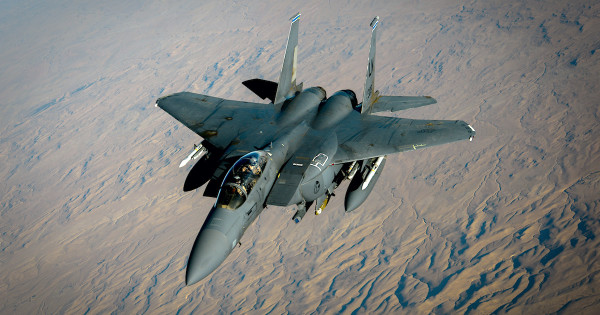

It’s been nearly 20 years since the most recent F-15 fighter jet rolled off an assembly line for the U.S. Air Force, and the service is officially looking to add a fresh variant of the aircraft to its inventory.
On Tuesday, a pair of twinpre-solicitation notices posted to the U.S. government’s contract opportunities hub announced the Air Force’s intent to procure both upgraded Boeing-made F-15EX fighters and fresh General Electric F110 jet engines associated with the new aircraft.
News of the solicitations was first reported by Aviation Week’s Steve Trimble, who noted that the single-source notices mark “the first concrete steps to signing new orders and reviving U.S. F-15 procurement after a nearly 20-year hiatus.”
The last year that Boeing produced an F-15 fighter for the Air Force was in 2004, according to the St. Louis Post-Dispatch.
The acquisition of the F-15EX is specifically intended as “a refresh to the F-15C/D fleet and augment the F-15E fleet,” according to one of the pre-solicitation notices. Here are some of the aircraft’s technical details and intended capabilities, as first reported by The War Zone way back in July 2018:
The F-15X configuration is impressive as it includes a flat-panel glass cockpit, JHMCS II helmet mounted display (HMD), revised internal wing structure, fly-by-wire controls, APG-82 AESA radar, activation of outer wing stations one and nine, advanced mission computer, low-profile heads-up display, updated radio and satellite communications, the highly advanced Eagle Passive Active Warning Survivability System (EPAWSS) electronic warfare and electronic surveillance suite, Legion Pod-mounted infrared search and track system (IRST) and the list goes on.
With the help of the company’s new AMBER missile carrying racks, the F-15X will be able to carry a whopping 22 air-to-air missiles during a single sortie. Alternatively, it could fly with eight air-to-air missiles and 28 Small Diameter Bombs (SDBs), or up to seven 2,000 lb bombs and eight air-to-air missiles. We are talking crazy weapons hauling capabilities here. Keep in mind that the F-15C/D Eagle can carry eight air-to-air missiles currently, and the penultimate Eagle variant that is currently being built, the F-15SA, can carry a dozen.
The fiscal year 2020 National Defense Authorization Act that President Donald Trump signed into law in December provided the Air Force with $1.1 billion to procure up to eight F-15EX aircraft, including two prototypes, ahead of testing by the service.
The aircraft’s inclusion in the fiscal year 2020 defense budget wasn’t easy: In September 2018, then-Air Force Secretary Heather Wilson in September stated that the Air Force had no interest in picking up the fourth-generation F-15EX over additional fifth-generation F-35 Joint Strike Fighters.
“We are currently 80 percent fourth-gen aircraft and 20 percent fifth-generation aircraft,” Wilson told Defense News at the time. “In any of the fights that we have been asked to plan for, more fifth gen aircraft make a huge difference, and we think that getting to 50-50 means not buying new fourth-gen aircraft, it means continuing to increase the fifth generation.”
After Wilson resigned in March 2019, the Air Force reversed course, proposing a buy of eight F-15EX aircraft rather than the Pentagon’s original proposal of a dozen as a “short-term patch” to replace the service’s aging fourth-generation F-15C fleet without cannibalizing spending for the F-35.
“We absolutely adamant that the F-35 program, the program of record, absolutely stays on track and we don’t take a dime out of the F-35,” as Air Force Chief of Staff Gen. David Goldfein told the Senate Armed Services Committee the following April.
